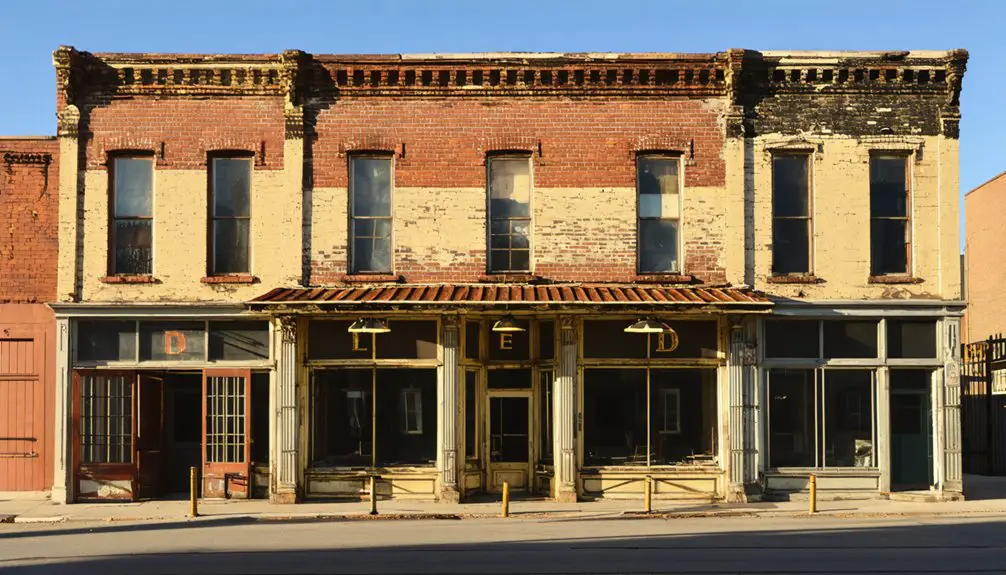You won’t find Condon among Oregon’s ghost towns – this thriving community of 682 residents stands as a symbol of preserved history meeting modern liveliness. Founded in the 1870s around Summit Springs, Condon evolved from William Potter’s settlement into a Victorian-era wheat farming hub. Today, you’ll discover a beautifully maintained National Historic District downtown alongside active agriculture operations. The story of how this town defied the fate of neighboring ghost towns reveals an inspiring tale of preservation.
Key Takeaways
- Condon is not a ghost town but an active community, despite experiencing economic decline after railroad and sawmill closures in the 1970s.
- The town maintains a preserved Victorian-era Main Street with 13 restored historic buildings from 1893-1906.
- Population decreased significantly after the closure of Kinzua Pine Mills and Union Pacific Railroad operations in the late 20th century.
- The community actively preserves its architectural heritage through the Main Street Revitalization Project, investing $750,000 in restoration efforts.
- Agriculture, particularly wheat and barley farming, continues to sustain Condon’s economy and prevents it from becoming a ghost town.
The Birth of Summit Springs Settlement
While many Oregon settlements began as mining camps or military outposts, Summit Springs emerged in the mid-1870s around a natural freshwater spring formed by underground Columbia River tributaries.
You’ll find that William Potter, a sheepherder, became the area’s first permanent settler, officially platting the land in 1883. The settler experiences in this region initially centered on grazing cattle and sheep across the expansive prairie lands. The area became home to numerous cowboys and sheepherders who shaped the town’s early character. The Tenino Indians had hunted and gathered in these lands for thousands of years before settlement.
You’d be amazed how the volcanic ash-enriched soil and reliable spring water, used by both settlers and Native Americans, created perfect conditions for agricultural practices to flourish.
When Potter faced financial difficulties, he transferred the land to the Condon and Cornish legal firm, setting the stage for the settlement’s transformation into a thriving farming community.
From Potter’s Land to Condon’s Legacy
After financial difficulties forced William Potter to relinquish his land holdings, the Condon and Cornish legal firm from Arlington, Oregon, acquired the settlement in the early 1880s.
The firm’s land ownership quickly transformed the area’s destiny, as they began selling plots to enthusiastic settlers and investors in 1885.
You’ll find the town’s name traces back to Harvey C. Condon, a lawyer at the firm and nephew of renowned Oregon geologist Thomas Condon.
When David B. Trimble established the post office in 1884, he chose to honor Harvey by naming it Condon.
This legal legacy became permanent when the town officially incorporated on February 10, 1893.
The Condon name reflects both the family’s influence in the region’s development and Thomas Condon’s scientific contributions, particularly his work with the nearby John Day Fossil Beds.
Today, visitors can enjoy the town’s historic charm while dining at popular establishments like the Buckhorn Saloon and Sandi’s.
To prevent confusion with other locations sharing the Condon name, the town maintains clear place name disambiguation in historical records.
Railroad Era and Economic Growth
You’ll find that Condon’s transformation into a bustling commercial center began with the Oregon Railway & Navigation Company‘s 1905 branch line from Arlington, doubling the town’s population to 1,000 residents by 1910.
The arrival of the Condon-Kinzua-Southern railroad in 1929 further expanded trade opportunities, establishing the town as Gilliam County’s primary hub for grain and livestock shipments. Similar to other agricultural regions in Oregon, the introduction of mechanical grain threshers revolutionized wheat production efficiency in the area. Union Pacific Railroad provided financial backing and eventually took ownership of the line, strengthening the region’s transportation infrastructure.
While these rail connections spurred rapid development of houses and businesses throughout the early 1900s, the eventual decline of railroad operations and the closure of the Kinzua Pine Mills in the 1970s marked the end of Condon’s peak commerce era.
Union Pacific Branch Line
In 1905, the Union Pacific Railroad completed its ambitious 44-mile Condon Branch, stretching from Arlington to Condon in north-central Oregon. This essential railroad infrastructure connected the region’s agricultural communities to larger markets, enabling local farmers to transport their wheat, wool, and livestock with unprecedented efficiency. As one of America’s Class I freight railroads, Union Pacific’s presence in Oregon showcased its extensive reach across the western United States.
You’ll find the branch line’s history marked by significant changes, including the massive 1967 relocation prompted by the John Day Dam project. The line was eventually abandoned in 1993, except for a small section serving waste management operations.
The railroad’s freight transport operations expanded in 1928 when it incorporated the Kanzua sawmill into its network. However, by the late 1970s, sawmill closures triggered a decline in freight revenue.
Peak Commerce Years
Following the railroad’s arrival in 1905, Condon experienced a transformative economic boom that would define its golden age.
You’d have witnessed the town’s population double as it evolved into a bustling hub of agricultural commerce and timber industry activity. By 1910, the population reached 1,000, while the Kinzua Pine Mill’s operations brought prosperity through regular lumber shipments on the new rail line. Similar to other Oregon towns, water transportation routes had previously limited the region’s economic potential. The mill provided vital employment, with up to 330 workers during peak production years.
- Farmers and ranchers flocked to Condon’s markets, making it the region’s primary trading center for grain and livestock.
- New commercial buildings and services sprouted up to serve the growing population.
- The Condon, Kinzua & Southern Railroad transformed the town into a crucial shipping hub, connecting local products to broader markets.
The town’s peak commerce years showcased the perfect union of agriculture, timber, and rail transportation, creating unprecedented economic vitality.
Railroad Decline Impact
While Condon’s prosperity seemed unstoppable during its peak years, the town’s economic fortunes began to unravel in 1953 when Kinzua Pine Mills relocated its operations eastward.
You’ll find that this marked the beginning of a painful economic shift, as railroad traffic steadily declined throughout the following decades.
The mid-1970s recession dealt another blow when Kinzua Corporation temporarily closed its mill, and track conditions deteriorated to dangerous levels.
By 1975, Union Pacific had shuttered its Condon depot, and rail operations ceased entirely in 1976.
The railroad nostalgia that followed couldn’t mask the harsh reality: with the removal of 125 homes in 1982 and the planting of 400,000 Ponderosa Pines over the old mill site, Condon’s industrial era had come to an end.
Main Street’s Architectural Heritage

You’ll find Condon’s Main Street lined with beautifully preserved Victorian-era storefronts that date back to the city’s economic peak between 1899 and 1910.
The historic buildings showcase classic design elements including decorative cornices, large display windows, and locally sourced brick and basalt construction materials.
These architectural treasures gained national recognition when the Condon Commercial Historic District was added to the National Register of Historic Places in 1998, sparking extensive restoration efforts that continue to protect the town’s heritage.
Historic Building Preservation
As you stroll down Condon’s Main Street today, you’ll discover a remarkable collection of preserved historic buildings that tell the story of this eastern Oregon town’s architectural heritage.
Since 1989, community involvement has driven the preservation of 13 buildings constructed between 1893 and 1906, maintaining their architectural authenticity. The $750,000 Main Street Revitalization Project has breathed new life into these historic structures, while keeping their original character intact.
- The S.B. Barker Building stands as a prime example of Italianate architecture, featuring flat roofs, tall windows, and ornate cornices.
- The Historic Downtown District, listed on the National Register in 1998, showcases early 20th-century western mercantile design.
- Local business owners work closely with the city to preserve facades while adapting interiors for modern use.
Victorian Storefront Design Elements
The Victorian storefronts lining Condon’s Main Street showcase an impressive array of late 19th-century architectural elements that defined the town’s commercial prosperity.
You’ll find striking false fronts reaching skyward, creating an illusion of grandeur with their ornate cornices and decorative parapets. The storefront aesthetics feature tall, narrow display windows flanked by wooden pilasters, while recessed entryways welcome visitors through expertly crafted doors with glass panels.
The architectural significance of these buildings lies in their detailed craftsmanship, from the carved wooden moldings to the transom windows that filter natural light into the shops.
Each structure maintains its period authenticity with double-hung sash windows on upper floors and locally sourced materials like wood clapboard and dressed stone, reflecting the town’s economic peak during the Victorian era.
The Air Force Station Years
During the height of Cold War tensions, Condon Air Force Station emerged as a vital defensive outpost when it was activated in 1951. The 636th Aircraft Control and Warning Squadron manned this air defense installation, equipped with cutting-edge radar technology to protect America’s Pacific Northwest from potential Soviet threats.
The Condon Air Force Station served as America’s watchful eye, its radar systems scanning Pacific skies for Cold War adversaries.
You’ll find the station underwent significant technological evolution throughout its operational years, shifting from manual tracking to the advanced SAGE computer system in 1960. The facility remained vigilant until its closure in 1970, when changing defense needs led to its deactivation.
- Massive radar installations dotted the landscape, scanning the skies 24/7
- Interceptor aircraft stood ready to scramble at a moment’s notice
- Advanced computer systems processed radar data in real-time, coordinating regional defense
Nobel Laureate’s Hometown

Long before Condon became a military outpost, this small Oregon town nurtured one of science’s most brilliant minds.
In the early 1900s, young Linus Pauling walked these streets, surrounded by wheat fields and the rugged Oregon landscape that would shape his formative years.
You’ll find Pauling’s influence woven deep into Condon’s pride, as the town celebrates its connection to the only person who’d earn two unshared Nobel Prizes.
His groundbreaking work in chemistry and passionate advocacy for peace began in this close-knit community, where personalized attention in local schools helped foster his scientific curiosity.
Today, Condon honors his legacy through annual celebrations on February 28th, Linus Pauling Day, reminding visitors that even the smallest towns can produce world-changing minds.
Downtown Revival Projects
As Condon confronts modern-day challenges, ambitious revival projects are breathing new life into its historic downtown core.
You’ll find major revitalization efforts underway, with over $750,000 invested in the Main Street Revitalization Project and an additional $644,722 from Oregon’s Main Street grant program.
The centerpiece of this economic development push is the historic Condon Round-Up building, which you’ll see transforming through extensive rehabilitation work.
- Restored brick façades and storefronts recapturing the town’s century-old character
- Mixed-use spaces combining ground-floor businesses with upper-level housing
- Modern safety upgrades and ADA compliance while preserving historical integrity
These strategic investments signal Condon’s commitment to its future, creating opportunities for entrepreneurs and strengthening the local economy through thoughtful preservation of its architectural heritage.
Preserving Historical Landmarks

You’ll find Condon’s commitment to historical preservation evident in its extensive building restoration projects, particularly along Main Street, which earned National Register of Historic Places designation in 1998.
The town’s architectural heritage, featuring late 19th-century commercial buildings with detailed facades and ornate cornices, represents a significant era in Oregon’s development.
Through public-private partnerships and grant funding, you can now witness how these carefully restored landmarks serve both as tourist attractions and functional spaces for modern businesses while maintaining their historical integrity.
Historic Buildings Restoration Project
The historic buildings of Condon, Oregon have undergone extensive restoration efforts through a thorough Main Street Revitalization Project, with over $750,000 invested by the city and local business owners.
You’ll find innovative restoration techniques being employed, from salvaging authentic 1800s materials to carefully dismantling and rebuilding structures while maintaining their historical integrity.
Strong community engagement has proven essential, with volunteers and local experts working together to preserve these architectural treasures.
- Original wooden components from period bunkhouses are carefully extracted and repurposed
- Historic windows and architectural details are meticulously recreated to match the original era
- Local historical societies provide guidance to guarantee restoration accuracy while meeting modern safety standards
Your support through events, tours, and volunteer opportunities helps keep these preservation efforts alive for future generations to experience.
Notable Architecture Worth Saving
Beyond the ongoing restoration work, Condon’s architectural heritage stands as a tribute to early 20th-century Western town development.
You’ll find remarkable examples of architectural significance along Main Street, where classic commercial storefronts showcase decorative brickwork, black basalt details, and original cornices. The former Hollen and Sons Hardware Store, now housing the Gilliam County Library, demonstrates successful adaptive reuse while maintaining historic preservation standards.
The district’s Norman Rockwell-esque charm emerges through Victorian and Craftsman influences, period-specific signage, and vintage interior elements in former soda fountains and saloons.
These buildings tell stories of notable residents like Thomas Condon and Linus Pauling. While facing modern challenges, the structures’ authentic wooden window frames, recessed entrances, and local stone materials represent irreplaceable pieces of Western architectural history.
Modern Farming Community Life
Despite significant changes in farming technology over the past century, modern life in Condon remains firmly rooted in its agricultural heritage, with wheat and barley farming dominating both the economy and cultural landscape.
You’ll find a tight-knit community of roughly 682 residents who’ve adapted traditional farming practices with contemporary machinery while preserving their cultural identity through the historic downtown district and communal spaces.
- You can witness massive combines rolling through endless fields of golden wheat, an indication of the region’s technological evolution from horse-drawn equipment.
- The restored main street serves as your connection to both past and present, housing essential services that cater to the farming community’s needs.
- You’ll experience a rhythm of life that follows the agricultural calendar, from spring planting to fall harvest, maintaining age-old traditions despite modern advances.
Comparing Condon to True Ghost Towns
While many Oregon ghost towns stand frozen in time as abandoned remnants of the past, Condon defies this categorization through its sustained liveliness and evolution. Unlike true ghost towns that experienced dramatic population collapse, Condon’s community resilience shines through its continuous growth since its 1884 establishment, maintaining vibrant commerce and infrastructure.
You’ll find Condon’s cultural significance preserved in its carefully restored historic downtown, where active businesses operate alongside architectural treasures listed in the National Register of Historic Places.
While ghost towns like Shaniko and Lonerock showcase only static remnants of their past, Condon flourishes with a working library, shops, and event spaces. The town’s Norman Rockwell-like atmosphere serves both tourists and locals, proving it’s far from a ghost town’s hollow shell.
Frequently Asked Questions
What Is the Average Annual Rainfall in Condon, Oregon?
You’ll experience about 14 inches of average precipitation annually, with weather patterns showing wetter months from fall through spring, and drier summers that help create your comfortable climate.
Are There Any Annual Festivals or Community Events Held in Condon?
You’d think a small town wouldn’t have much going on, but Condon’s packed with community traditions like the Annual Light Festival, summer artisan markets, and local celebrations including youth camps and family events.
What Dining Options and Accommodations Are Available for Visitors to Condon?
You’ll find local eateries like Wild Sage restaurant and The Condon Local café, plus comfortable hotel stays at the historic Hotel Condon or Condon Motel, both offering modern amenities and Wi-Fi.
How Far Is Condon From Major Oregon Cities Like Portland?
Like a hidden gem in Oregon’s tapestry, you’ll find yourself 154 miles east of Portland, with the drive taking about 3 hours through historic landmarks and culturally significant towns like Arlington and The Dalles.
What Outdoor Recreational Activities Can Visitors Enjoy Around Condon?
You’ll find scenic hiking trails at Thirtymile Creek, fossil hunting at local dig sites, fishing spots along creek beds, and wildlife photography opportunities. Plus, you can camp at Burns Park year-round.
References
- https://www.oregonencyclopedia.org/articles/condon/
- https://thatoregonlife.com/2016/04/road-trip-ghost-towns-eastern-oregon/
- https://en.wikipedia.org/wiki/Condon
- https://traveloregon.com/things-to-do/culture-history/ghost-towns/lonerock/
- https://en.wikipedia.org/wiki/List_of_ghost_towns_in_Oregon
- https://paulingblog.wordpress.com/2009/02/03/condon-oregon-paulings-wild-west/
- http://cherylhill.net/blog/2012/02/20/condon/
- https://goskate.com/go/tag/condon
- https://en.wikipedia.org/wiki/Gilliam_County
- https://www.familysearch.org/en/wiki/Gilliam_County



